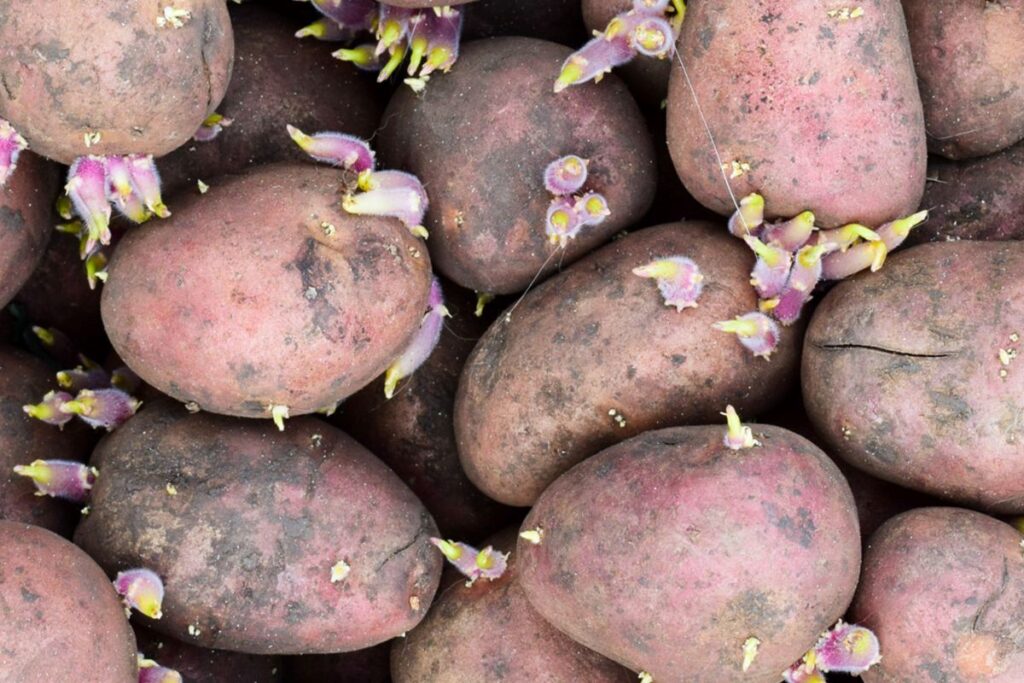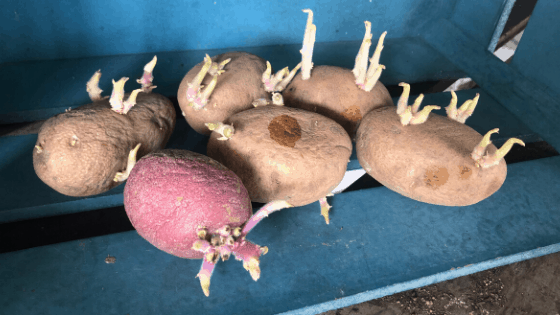As a gardening newbie trying to plant potatoes, you might find yourself asking, “Which side of a potato is right side up?” and “What happens if you plant potatoes upside down?”
I know that I once asked that very question!
When planting a potato, the eyes, which are little white bumps on its surface, should be facing up. However, planting a potato on the wrong side won’t prevent it from growing because the eyes can adjust and emerge from anywhere, ensuring upward growth.
For a perfect growing experience, you want the eyes upwards – but do not fear! Your potatoes will grow, pretty much however you plant them.
I’ve been growing my own potatoes for years, and in this article, I’m going to look at:
- Exactly what happens when you plant potatoes upside down
- My 8 top tips to grow absolutely amazing potatoes

What Happens If You Plant Potatoes Upside Down?
Gardeners always recommend planting your potatoes with the eyes facing up. If your seed potato has multiple eyes on all sides, pick the ones with the longest buds and let those face upward.
Doing this allows the buds to break through the soil much quicker. It will also promote smoother growth.
However, you don’t need to worry too much about whether your potato’s eyes are facing up or down. The buds will grow from various sides of the potato over time and eventually reach the surface regardless of their positioning.
If you planted your potato with its longest buds facing down, the extra time it takes to reach the soil is minimal, typically a few days to a week.
Potatoes are adaptable and can grow in a variety of conditions and positions. Some people even intentionally grow potatoes upside down to save space.
8 Top Tips For Growing Amazing Potatoes
Potatoes are a great choice for beginners as they’re easy to work with. You can plant them anywhere, from loose soil to pots to special “grow bags,” and in a variety of environmental conditions.
If you’re thinking of making a potato patch, here are some of the basic steps in growing potatoes to get you started.
1. Get a Seed Potato
Unlike other plants, potatoes don’t grow from regular seeds, but from seed potatoes. Seed potatoes are small tubers cultivated for planting potatoes.
You should buy these from farm stores because potatoes you find from groceries are usually sprayed with sprout-retardant. This retardant stops them from growing.
Ideally, you should get ones that have already sprouted. You’ll see if the seed potato has sprouted by the presence of small white sprouts coming from its eyes.
2. Pre-Sprout Your Seed Potato
If your seed potatoes haven’t sprouted, you can pre-sprout them by placing them in a warm well-lit location such as a tray or container filled with moistened soil.
The potatoes’ eyes, or the little white bumps on a potato’s surface where the sprouts emerge, should be facing up.
Misting them regularly and ensuring proper air circulation will lead to quicker sprouting. Pre-sprouting will help your potatoes to grow faster when you finally plant them.
3. Cut and Cure Your Potato
Small potatoes, around the size of a ping pong ball, don’t need any cutting. However, you should cut the bigger ones, ensuring each piece has two or three eyes.
This practice prevents overcrowding, allowing each stem to thrive and produce larger potatoes during harvest.
After cutting, you should cure the cut pieces by setting them out in the sun for 3-5 days. Doing so will allow your potato to become calloused, which prevents rot.
4. When to Plant Your Potato
If you live in a cold climate, the best time to plant your potato is during mid to late spring. This timing allows the seed potatoes to be planted when the soil has thawed and there’s a lower risk of frost.
In warmer climates, it’s best to plant potatoes in late summer or late winter to avoid the hottest months.

5. How to Plant Your Potato
Plant the small seed potatoes and seed potato segments with the eyes facing up into a hole or trench approximately 6 inches deep.
Ensure that each potato piece is spaced 12 inches apart in all directions.
Evenly distribute two tablespoons of low-nitrogen, high-phosphorus fertilizer between each piece. Cover them with 2 inches of soil and water well.
6. Hill Around the Stems
This step is crucial to give you a better harvest. All you need to do is mound the soil around the new vine growth.
Once the green sprouts grow to approximately 8 inches in height, cover most of them in soil, straw, or leaves, leaving only the top 6 inches exposed.
You can do this until your vines start to flower.
Hilling helps prevent seed potatoes from becoming exposed to sunlight, which can make your potato turn green and inedible. Hilling also provides stability to the vine as it grows and protects the plant from frost.
7. Care for Growing Potatoes
While caring for your growing potatoes, you need to ensure it’s getting the right conditions it needs to thrive.
Follow the specifications in the table to give your potato the ideal conditions for light, water, soil, temperature, and fertilizer.
| Factors for Plant Growth | Specifications |
| Light | The plant should get around 6-8 hours of full sun daily. |
| Water | Ensure that the plant receives a minimum of 1 inch of water on a weekly basis. |
| Soil | Loose soil with acidic pH of 5.0 to 6.0 |
| Soil Temperature | At least 45°F at planting |
| Fertilizer | Use organic, slow-release fertilizer at planting. Every few weeks feed with diluted liquid fertilizer or fish emulsion. |
8. Harvesting
If you want to harvest small potatoes, they can be ready in as little as ten weeks.
However, if you’re aiming for full-sized, mature potatoes, you’ll have to wait 80-100 days.
A good sign to watch out for is the vines. Around 2 weeks after the vines have flowered, you can start harvesting small, new potatoes.
Alternatively, you can wait for the vines to die down, which signifies that the potatoes have reached full maturity. Simply reach into the soil and pull the potatoes up by hand.
Conclusion
Planting potatoes with the eyes up or down isn’t as crucial as you may initially think.
While people generally recommend planting potatoes with the eyes up, this tuber can adapt and grow no matter what position you initially plant it in.
Potatoes are one of the easiest crops to work with. Growing them is a fun and straightforward process.
Just provide them with the necessary care, and you’ll get a bountiful harvest. Happy gardening and enjoy the delicious taste of homegrown potatoes!

